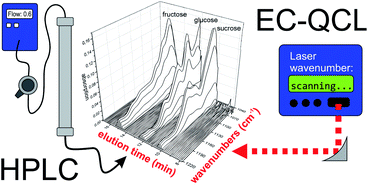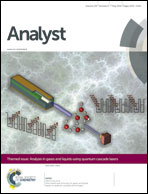High performance liquid chromatography with mid-infrared detection based on a broadly tunable quantum cascade laser
Abstract
This work introduces a tunable mid-infrared (mid-IR) external cavity quantum cascade laser (EC-QCL) as a new molecular specific detector in liquid chromatography. An EC-QCL with a maximum tunability of 200 cm−1 (1030–1230 cm−1) was coupled to isocratic high performance liquid chromatography (HPLC) for the separation of sugars with a cation exchange column (counter ion: Ca2+) and distilled water as the mobile phase. Transmission measurements in a 165 μm thick flow cell allowed for on-line coupling and independent quantification of glucose, fructose and sucrose in the concentration range from 5 mg mL−1 to 100 mg mL−1 in several beverages. The results obtained with the EC-QCL detector were found to be in good agreement with those obtained using a differential refractive index detector as a reference. The standard deviation of the method for the linear calibration was better than 5 mg mL−1 for all sugars and reached a minimum of 1.9 mg mL−1, while the DRI detector reached a minimum of 1 mg mL−1. Besides the quantification of sugars for which a calibration was performed, also chromatographic peaks of other components could be identified on the basis of their IR absorption spectra. This includes taurine, ethanol, and sorbitol.

- This article is part of the themed collection: Analysis in gases and liquids using quantum cascade lasers

 Please wait while we load your content...
Please wait while we load your content...